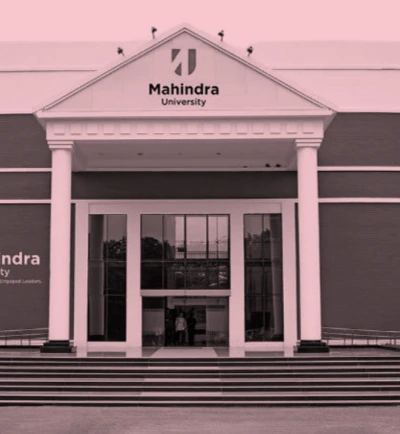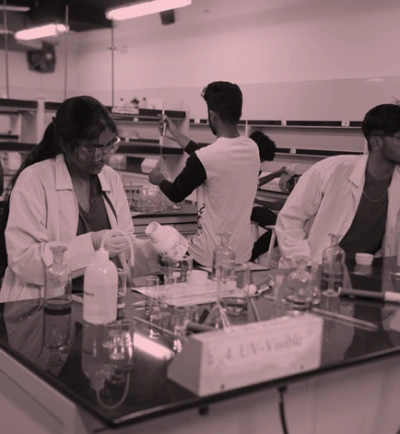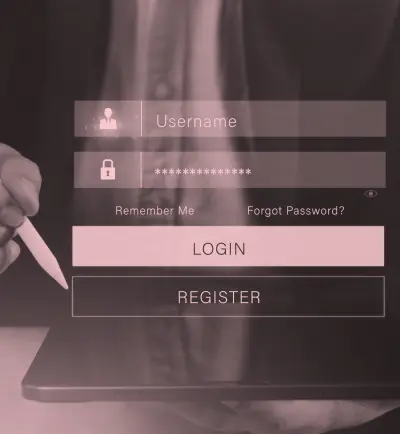Computation & Media
Overview
Our BTech Computation and Media (BTCM) is a four-year, eight-semester, intedisciplinary programme, rigorous and complex, involving a matrix of courses from Computer Science, Humanities and Social Sciences, Journalism and Mass Communication, and general engineering. It is a unique programme that lies at the cutting edge of media practice using emerging technology. It prepares our students to be engineers enabled to enter the news, entertainment, and user media and their related industries equipped with the skills and competencies required for the application of these new technologies.
An example of the carefully curated interdisciplinarity is that students learn language models, writing, media production, and the psychology of human-computer interaction so that they can adopt it in various ways in newsrooms, game development, film production, and advertising strategy.
Media, art and technology have interfaced with one another at each phase of technological development, from photography to the internet. Today’s technology includes the media consumer like never before. Not only is it interactive—it is quickly becoming immersive. The adoption of these new technologies has been across industries. However, these are primarily communicative technologies, and the communication-related industries are utilizing them, increasingly and in phases.
Game design is a thriving user-media industry that requires such a skill set. Game design entails the ability to use modelling and animation, immersive storytelling and, increasingly, Artificial Intelligence (AI). Like game design, sports media is another industry whose talent is in high demand in many countries.
In general, immersive storytelling is an exciting new norm whether in games themselves or in gamification forms: Industries such as tourism, which depend on promotional communication, may use augmented and virtual reality (AR/VR) technology, for example, and also blend artificial intelligence (AI). A new form of extended reality (XR) is increasingly being explored. Experiential and immersive storytelling in virtual, augmented, and mixed reality; data visualization; videos using 360-degree cameras and spherical film will form the pivot of the learning in our programme.
News broadcast has particularly benefited from the new technological ecosystem. For example, the sociological ramifications of technology were particularly on display when The New York Times used the XR technology to place the viewer in the middle of a refugee camp in Syria to experience war first-hand. By highlighting the horrors of conflict that are usually a distant and detached reality, the media consumer is suddenly involved in change-making. This is a journalistic function, and it comes with ethical concerns. Similarly, the United Nations has evolved the “UN VR App”, which highlights urgent problems and urges citizens at large to take action. Our student will straddle this complex and fascinating journey of tech-enabled mediated communication with sociological, cultural and ethical considerations.
Programme
Specific goals
There will be a heavy and increasing emphasis on concept and practice in each advanced semester, with appropriately close interactions with both scholarship and industry. By the end of the programme, a competent and specialized project will be expected.
Curricula (list of courses)
| Semester 1 | Semester 2 |
|---|---|
| JM1101 Learning to Learn | JM1201: History of Media |
| JM1102 Photography | JM1202: Visual Communication and Graphic Design |
| JM1103: Introduction to Media and Communication | JM1203: Introduction to Advertising, PR, Communication Management |
| JM1104: Literature, Art, Storytelling | JM1204: Fundamentals of Writing and Editing |
| JM1105: News Analysis I | JM1205: News Analysis II |
| JM1106: Data Communication and Basic Software | JM1206: Media Technologies |
| JM1107: Professional Communication | JM1108: Media, Gender, Human Rights |
| JM1209: Media Production I | |
| JM1298: Know your industry I | |
| JM1299: Social sensitization internship or Guided project |
| Semester I |
|---|
| Math I – Calculus & ODE |
| Earth and Environmental Sciences |
| Fundamentals of Drawing & Practice |
| Intro. To Comp. Sci. |
| Learning to Learn |
| Introduction to Media and Communication |
| Photography I: Still and Moving Images |
| Literature, Arts, and Storytelling |
| French I |
| Semester II |
|---|
| Math II – Linear Algebra, Complex Analysis |
| Physics – I |
| Discrete Mathematical Structures |
| Data Structures |
| Visual Communication and Graphic Design |
| Media and Information Literacy |
| Introduction to Game Design |
| Professional Ethics |
| French II |
| Semester III |
|---|
| Math III – Probability and Stats |
| Design and Analysis of Algorithms |
| Optimization Techniques for AI |
| Object Oriented Programming (C++ and Unreal) |
| Introduction to Interactive Storytelling |
| Introduction to VR/AR |
| Introduction to Media Forensics |
| Economics (fractal) |
| French III |
| Semester IV |
|---|
| Math IV – Numerical Methods |
| Theory of Computation |
| Social Media |
| Modelling and Animation |
| AI for Games and Media |
| Python Programming |
| Design Thinking |
| French |
| Financial Accounting (fractal) |
| Semester V |
|---|
| Operating Systems |
| DBMS |
| Digital Image Processing |
| Media Consumer Behaviour |
| Interactive Sound and Music |
| Strand course I |
| Entrepreneurship Practice and Lean Startup Management |
| HSS Elective I |
| French V (optional) |
| Semester VI |
|---|
| User Centered Design Methods |
| Computer Graphics |
| Data Visualization |
| Computational Creativity |
| Strand Course II |
| Elective I |
| 3rd year Project |
| Professional Development |
| HSS Elective II |
| French VI (optional) |
| Semester VII |
|---|
| Research Methods |
| Psychology of Human Computer Interaction |
| Strand Course III |
| Elective II |
| Final Year Project I |
| HSS Elective III |
| French VII (optional) |
| Semester VIII |
|---|
| Strand Course IV |
| Elective III |
| Final Year Project II |
| French VIII (optional) |
Stepping into the real world. Exposure to social and industrial practices is provided in well-guided ways under close faculty supervision.
Three internships are available—two of them mandatory. A social sector internship or initiative, two mandatory industry internships and one optional internships are included in the programme.
Assessment and grading
Assessment is seen as a dipstick measure of the progressive understanding of individual students. However, our continuous assessment is also evaluative, and counts towards the final grade. Specific, tangible and targeted output defines our assessment. Participation counts for a significant portion of the grade, and the student is expected to attend every class. Examinations are encouraged but de-emphasized, carrying a relatively small fraction of the overall grade. Plagiarism is routinely detected and will attract a zero grade. Repeated plagiarism will result in academic suspension and/or other measures.
A typical grading combination for a course may look like this:
One limitation of our pedagogic model is that it does not account for a student’s absence. Minimum absence is granted without permission; one more absence may be granted in advance at the discretion of the faculty member. A student cannot expect to “cope” or “compensate” after repeated absences—this is neither possible nor advisable in the interest of the successful completion of this demanding programme. Another limitation lies in our continuous assessment pattern, which, typically, will not allow a student to catch up on the grade because of absence or non-submission. Individual instructors may determine, on a per-case basis, whether an alternative is required because of the individual student’s situation.
Stepping into the real world. Exposure to social and industrial practices is provided in well-guided ways under close faculty supervision. We are fully geared up to guide students into specific internship and job opportunities.
Multiple internships are available. A social sector internship or initiative, at least one mandatory industry internship and one optional internship are included in the programme. These exposures to “real-world experiences” solidify the concepts-to-practice relationship.
The main career loci for graduating students are news, film, television, game design, advertising, public relations, and related industries. Some training in entrepreneurship will be made available as a part of an advanced curriculum.









